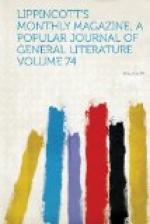of such monuments and memorials of the typographic
art and the historic past as have escaped the wreck
and been preserved to this day. That exhibition
and use must be governed by regulations which will
insure to the fullest extent the security and preservation
of the treasures intrusted to our care, in the enforcement
of which the trustees anticipate the sympathy and co-operation
of all scholars and men of letters, through whose
use and labors alone the public at large must chiefly
derive real and permanent benefit from this and all
similar institutions.” The “regulations”
adopted by the trustees for the preservation of their
treasures do not seem unreasonable. Admission
is by ticket, which may be procured of the librarian
by addressing him by mail. We have space for
but the briefest possible glimpses at these treasures.
The chief rarities in typography are found in the
north and south libraries on the first floor.
In “first editions” it would be difficult
to say whether the library prides itself most on its
Bibles, its Miltoniana, or its Shakesperiana.
In Bibles the whole art of printing with movable types
is fully portrayed, the series beginning with the
“Mazarin,” or Gutenberg, Bible, the first
book ever printed with movable types. There are
Bibles in all languages. There is the first complete
edition of the New Testament in Greek ever published,
its title-page dated Basle, 1516. In a glass case
in the north library are the four huge “Polyglot”
Bibles, marvels of typography, known as the Complutensian,
Antwerp, Paris, and English Polyglots. In the
same case repose the Codex Sinaiticus, Codex Alexandrinus,
and Codex Vaticanus,—three great folios,
in the original Greek and Hebrew, sacred to scholars
as the works on which all authority for the Scriptures
rests. Tyndale’s New Testament, the first
ever printed on English ground, dated London, 1536,
is here, and that rare copy of the King James version
known as the “Wicked Bible.” In this
copy the printer, as a satire on the age, omitted
the word “not” from the seventh commandment,
and for this piece of waggery was heavily fined, the
money going, it is said, to establish the first Greek
press ever erected at Oxford. Among its “first
editions” the library has that of Homer, 1488,
and that of Dante, 1472. The Milton collection
deserves special notice: in addition to the first
editions of the poet’s various works, it contains
a folio volume of letters and documents pertaining
to Milton and his family, with autograph manuscripts
giving exceedingly interesting details of the poet’s
private life and fortunes. One of these is a
long original letter from Milton himself to his friend
Carlo Dati, the Florentine, with the latter’s
reply; there are also three receipts or releases signed
by Milton’s three daughters, Anne Milton, Mary
Milton, and Deborah Clarke, a bond from Elizabeth Milton,
his widow, to one Randle Timmis, and several other
agreements and assignments, with the autographs of
attesting witnesses. In folio editions of Shakespeare,




